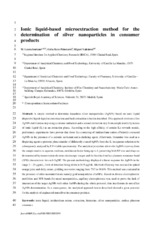Ionic-liquid-based microextraction method for the determination of silver nanoparticles in consumer products
Autor
Soriano, M. Laura
Ruiz-Palomero, Celia
Valcárcel, M.
Editor
SpringerFecha
2019Materia
Ionic liquidImidazolium cation
Extraction
Histamine
Silver nanoparticles
Surface plasmon resonance
METS:
Mostrar el registro METSPREMIS:
Mostrar el registro PREMISMetadatos
Mostrar el registro completo del ítemResumen
A simple method to determine hazardous silver nanoparticles (AgNPs) based on ionic liquid (IL) dispersive liquid–liquid microextraction and back-extraction is described. This approach involves AgNP stabilization using a cationic surfactant followed by extraction from the sample matrix by means of an IL as an extraction phase. Certain ILs have high affinity for metals, and preliminary experiments showed that those ILs consisting of imidazolium cation efficiently extracted AgNPs in the presence of a cationic surfactant and a chelating agent. Afterward, histamine was used as a dispersing agent to promote phase transfer of differently coated AgNPs from the IL in aqueous solution to be subsequently analyzed by UV–visible spectrometry. The analytical procedure allows AgNPs to be recovered from the sample matrix in an aqueous medium, the enrichment factor being up to 4, preserving both AgNP size and AgNP shape as demonstrated by transmission electron microscopy images and the localized surface plasmon resonance band characteristic of each AgNP. The present method exhibited a linear response for AgNPs in the range from 3 to 20 μg/mL, the limit of detection being 0.15 μg/mL. Method efficiency was assessed in spiked orange juice and face cream, yielding recoveries ranging from 75.7% to 96.6%. The method was evaluated in the presence of other nanointerferents (namely, gold nanoparticles). On the basis of diverse electrophoretic mobilities and surface plasmon resonance bands for metal nanoparticles, capillary electrophoresis was used to prove the lack of interaction of the target AgNPs with gold nanoparticles during the whole protocol; thus, interferents do not affect AgNP determination. As a consequence, the analytical approach described has great potential for the analysis of engineered nanosilver in consumer products.

